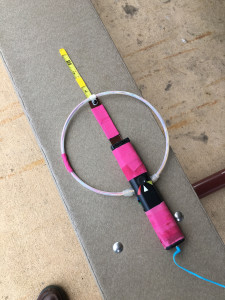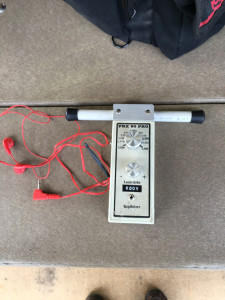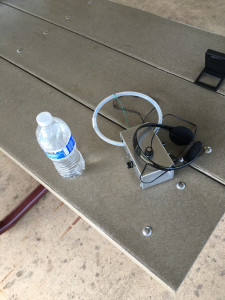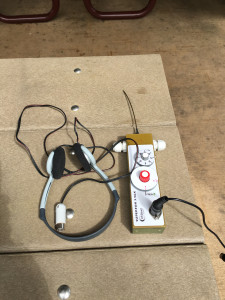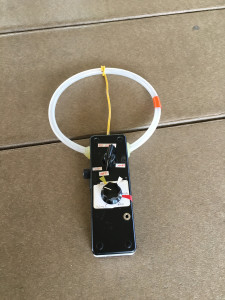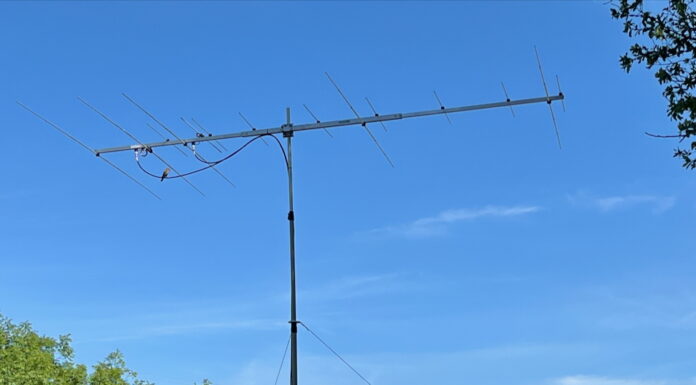I’m reporting from Berry Springs Park, near Georgetown, TX, where the Wednesday practice session was held for the USA ARDF Championships.
Actually, I’m back home with butt firmly in chair once again writing blog posts like I do most days, this time it’s my own blog.
ARDF Foxhunting
While I’ve observed many 2 meter foxhunts for Scouts over the years, I’ve never actually run a course. Plus, this practice session was for 80 meters ARDF. I’ve always been interested in the 80 meter version as the receivers are simple, the antennas small, and with no reflected signals, finding the transmitters should be simpler. Note the emphasis on the should be.
ARDF consists of finding hidden transmitters under a time constraint. At the start you’re provided a map of the area you’ll be searching. You can see nearby the map I was provided at the practice session.
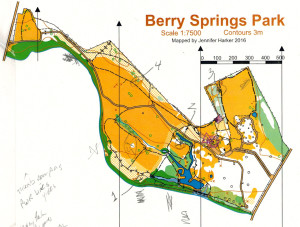 Once you’re off the starting line, you can take directional bearings for the transmitters. Each of the five transmitters are on the air for one minute. They key their number. That way you can get a bearing on all five, plot it on your map, and then determine how you want to run the course for the quickest time. Which is your initial assessment of the optimum path to pick up all transmitters as you move across the landscape.
Once you’re off the starting line, you can take directional bearings for the transmitters. Each of the five transmitters are on the air for one minute. They key their number. That way you can get a bearing on all five, plot it on your map, and then determine how you want to run the course for the quickest time. Which is your initial assessment of the optimum path to pick up all transmitters as you move across the landscape.
As you move toward the first transmitter, you take additional bearings helping you better pinpoint the location of the transmitters and make sure you’re actually getting closer to the transmitter you’ve selected.
At the end of finding all the transmitters, you tune to the frequency of the home transmitter and move to the end of the course. Clocking out with your finishing time.
That’s the overall process. You can learn more at the website Homing In, The Art and Science of Radio Direction Finding. In my preparation, I also picked up the book Radio Orienteering – The ARDF Handbook.
USA ARDF Championships
 I first realized that the championships would be nearby when I saw the ARRL article Texas to Host US ARDF Championships in April. At the time I couldn’t quite fit it on my schedule. But a few other nudges and visits to their website Texas ARDF helped me target the Wednesday practice session. I couldn’t quite fit in the weekend competition events, but I could at least experience this radio sport and do so in a non-competitive environment. And I felt it would be less embarrassing to show off my complete incompetence in practice.
I first realized that the championships would be nearby when I saw the ARRL article Texas to Host US ARDF Championships in April. At the time I couldn’t quite fit it on my schedule. But a few other nudges and visits to their website Texas ARDF helped me target the Wednesday practice session. I couldn’t quite fit in the weekend competition events, but I could at least experience this radio sport and do so in a non-competitive environment. And I felt it would be less embarrassing to show off my complete incompetence in practice.
ARDF Equipment
Once I realized I could attend, I needed to pick up a few things. I borrowed a compass from my daughter, the Venturing Ranger Award holding outdoors person, and I purchased an 80 meter receiver from QRVTronics.com. It’s a $55 receiver with a whip sense antenna and a ferrite rod antenna. The kit version is $40.
The ferrite rod antenna allows you to turn it toward the minimum received signal to find the bearing for the transmitter. But, since it is bi-directional, you don’t yet know the exact direction. Pressing a “sense” button on the receiver adds the whip antenna and this sets up a cardiod pattern to one side of the receiver. That then can point out the specific direction of the transmitter. Added to the bearing direction, with two choices 180 degrees from one another, you’ve got a good idea of direction. My mentor, more on him later, added that you can also use the signal strength, or volume on these simple receivers, to help pinpoint distance.
While I had picked up a ready-made simple receiver, in looking over the other receivers in use at the practice session most were homebrew. A number used loop antennas and I really like the use of tape measure sense antennas, preventing snapping them off in the woods. They allowed me to take some photos, see the nearby gallery.
ARDFers – Wonderful Group
Prior to the championships, Brian Coleman, KB0MAP, note the call sign, had encouraged me in my efforts. He’s a Scouter, active orienteering enthusiast, and ARDFer involved at the 2017 National Scout Jamboree and worked the 2015 USA ARDF championships. He wasn’t able to attend this event but reached out to Joe Moell, K0OV, ARRL ARDF coordinator who runs www.homingin.com, and Marvin Johnston, KE6HTS. They both saw my K5ND license plate and greeted me in the parking lot as I got out of the car. That was an incredible welcome to ARDF.
Of the roughly 20 people at the practice session, I talked to everyone. Not because I’m outgoing, but because they were so welcoming and helpful, not to mention courteous and kind. In fact, Dale Hunt, WB6BYU, IARU Region II ARDF coordinator, author of an 2005 QST article on an ARDF 80 meter receiver, offered to serve as my mentor on the course. I gladly consented to this guided tour of ARDF from a true expert.
I will also note that so many also shared openly their tactics and approach to finding transmitters, running the course, etc. We also talked a great deal about Scouting and involving youth in ARDF. What a wonderful group of people. Newcomers are truly welcomed.
ARDF Practice Course
This particular course was fairly small, open, and relatively flat. That made it easier than most. Once away from the start, we took some bearings on the five transmitters. I learned that my receiver’s volume control needed to be labeled, turning down the volume when I should have turned it up. I also learned that transmitter one was actually sending MOE in Morse Code rather than MO1. Likewise, transmitter two was MOI, and then MOS, MOH, and MO5.
Another lesson was that placing your map in a clipboard with a metal clip was a bad idea as it greatly influenced the compass. Then I learned that 80 meter signals travel down power lines and maintain a fair bit of strength. Thankfully, Dale was there to help me get a clue for most of these issues. Yes, you can read all about this stuff, but you need to put it into practice to find the real lessons.
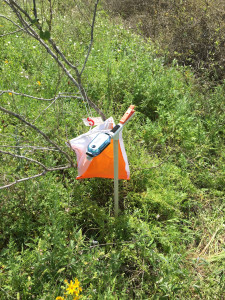 We tracked down the first transmitter, which we determined was the furthest away from the start. It was felt that this would give us good bearings on the other transmitters as we traveled and allow us to hit those transmitters on our way to the finish. You can see the marker and electronic tag system in the photo nearby.
We tracked down the first transmitter, which we determined was the furthest away from the start. It was felt that this would give us good bearings on the other transmitters as we traveled and allow us to hit those transmitters on our way to the finish. You can see the marker and electronic tag system in the photo nearby.
Left to my own, I’m sure I would have wandered around quite a bit. Plus, I would have spent a lot of time taking bearings, lining up my map with compass, and drawing lines across the map. Instead, with Dale’s guidance, we took bearings and set a good idea of direction and location, but didn’t draw out intersecting bearings. That would have been too time consuming and not provided enough benefit for the time spent.
The course used an electronic tagging system. This logged you onto the course and then with each transmitter it noted the time you found it. And finally at the end of the course you logged out. This allowed accurate results. Here’s the practice session results. I came in last for the Men’s Over 60 Category. We walked the course with a few lessons along the way and finished at 72 minutes. I see that one completed the course in 35 minutes. There was some running involved in that time.
ARDF Radio Sport Outdoors
 I’ve always felt that ARDF Foxhunting was exactly suited to Scouting. It’s outdoors and it involves technology as well as competition. What a perfect combination. My experience at the USA ARDF Championships proved that out. Plus, it introduced me to some wonderful people.
I’ve always felt that ARDF Foxhunting was exactly suited to Scouting. It’s outdoors and it involves technology as well as competition. What a perfect combination. My experience at the USA ARDF Championships proved that out. Plus, it introduced me to some wonderful people.
I’m definitely going to try to do more of this in the future. Plus, it’s given me still further motivation to implement ARDF at the 2017 National Scout Jamboree.
If you get a chance to participate in the radio sport without chairs, I recommend it.


